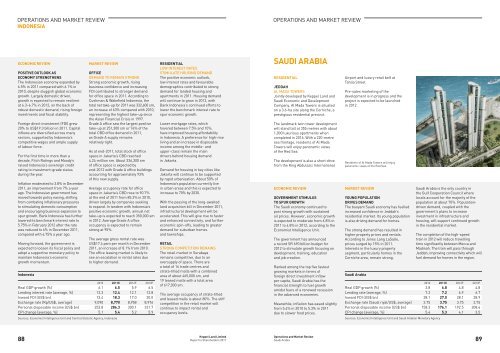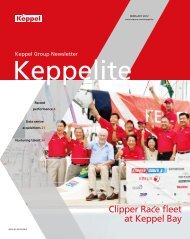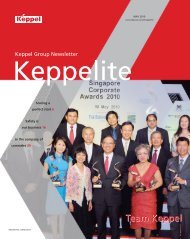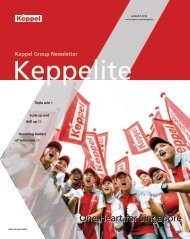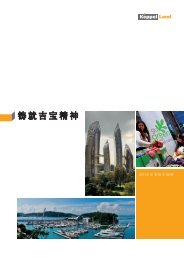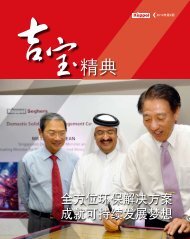Download PDF - (8.87 MB) - Keppel Land
Download PDF - (8.87 MB) - Keppel Land
Download PDF - (8.87 MB) - Keppel Land
- No tags were found...
Create successful ePaper yourself
Turn your PDF publications into a flip-book with our unique Google optimized e-Paper software.
OPERATIONS AND MARKET REVIEWINDONESIAOPERATIONS AND MARKET REVIEWECONOMIC REVIEWPOSITIVE OUTLOOK ASECONOMY STRENGTHENSThe Indonesian economy expanded by6.5% in 2011 compared with 6.1% in2010, despite sluggish global economicgrowth. Largely domestic driven,growth is expected to remain resilientat 6.3–6.7% in 2012, on the back ofrobust domestic demand, rising foreigninvestments and fiscal stability.Foreign direct investment (FDI) grew20% to US$19.3 billion in 2011. Capitalinflows are diversified across manysectors, supported by Indonesia’scompetitive wages and ample supplyof labour force.For the first time in more than adecade, Fitch Ratings and Moody’sraised Indonesia’s sovereign creditrating to investment-grade statusduring the year.Inflation moderated to 3.8% in December2011, an improvement from 7% a yearago. The Indonesian government hasmoved towards policy easing, shiftingfrom combating inflationary pressuresto stimulating domestic consumptionand encouraging business expansion tospur growth. Bank Indonesia has furtherlowered its benchmark interest rate to5.75% in February 2012 after the ratewas reduced to 6% in December 2011,compared with 6.75% a year ago.Moving forward, the government isexpected to loosen its fiscal policy andadopt a supportive monetary policy tomaintain Indonesia’s economicgrowth momentum.IndonesiaMARKET REVIEWOFFICEDEMAND TO REMAIN STRONGStrong economic growth, risingbusiness confidence and increasingFDI contributed to stronger demandfor office space in 2011. According toCushman & Wakefield Indonesia, thetotal net take-up for 2011 was 332,600 sm,an increase of 63% compared with 2010,representing the highest take-up sincethe Asian Financial Crisis in 1997.Grade A office saw the largest positivetake-up at 251,300 sm or 76% of thetotal CBD office demand in 2011,as Grade A supply remainsrelatively tight.As at end-2011, total stock of officespace in Jakarta’s CBD reached4.24 million sm. About 336,300 smof office space is expected byend-2012 with Grade A office buildingsaccounting for approximately 93%of this new supply.Average occupancy rate for officespace in Jakarta’s CBD rose to 90.7%at the end of 2011 from 85.2% in 2010,driven largely by companies seekingto expand. In tandem with Indonesia’spositive economic growth, annual nettake-up is expected to reach 350,000 smin 2012. Average Grade A officeoccupancy is expected to remainstrong at 95%.The average gross rental rate wasUS$17.4 psm per month in December2011, an increase of 8.1% from 2010.The office leasing market is likely tosee an escalation in rental rates dueto higher demand.2010 2011E 2012F 2013FReal GDP growth (%) 6.1 6.5 5.9 6.5Lending interest rate (average, %) 13.3 12.4 12.1 12.8Inward FDI (US$ bn) 13.4 18.3 17.0 20.0Exchange rate (Rp/US$, average) 9,090 8,770 8,958 8,976Personal disposable income (US$ bn) 253.8 286.3 300.1 331.7CPI change (average, %) 5.1 5.4 5.2 5.9Sources: Economist Intelligence Unit and Central Statistic Agency, IndonesiaRESIDENTIALLOW INTEREST RATESSTIMULATE HOUSING DEMANDThe positive economic outlook,low interest rates and favourabledemographics contributed to strongdemand for landed housing andapartments in 2011. Housing demandwill continue to grow in 2012, withBank Indonesia’s continued efforts tolower the benchmark interest rate tospur economic growth.Lower mortgage rates, whichhovered between 7.5% and 10%,have improved housing affordabilityin Indonesia. A preference for high-riseliving and an increase in disposableincome among the middle- andupper-class remain the maindrivers behind housing demandin Jakarta.Demand for housing in key cities likeJakarta will continue to be supportedby rapid urbanisation. About 50% ofIndonesia’s population currently livein urban areas and this is expected toincrease to 70% by 2030.With the passing of the long-awaitedland acquisition bill in December 2011,infrastructural development will beaccelerated. This will give rise to fasterand enhanced connectivity, and furthereconomic spin-offs, leading to greaterdemand for suburban homesand townships.RETAILSTRONG COMPETITION REMAINSThe retail market in Surabayaremains competitive, due to anoversupply of space. There area total of 16 trade centres andstrata-titled malls with a combinedarea of about 465,000 sm, and19 leased malls with a total areaof 617,000 sm.The average occupancy of strata-titledand leased malls is about 80%. The stiffcompetition in the retail market willcontinue to impact rental andoccupancy levels.SAUDI ARABIARESIDENTIALJEDDAHAL MADA TOWERSJointly developed by <strong>Keppel</strong> <strong>Land</strong> andSaudi Economic and DevelopmentCompany, Al Mada Towers is situatedon a 3.6-ha site along the Corniche, aprestigious residential precinct.The landmark twin tower developmentwill stand tall at 355 metres with about1,000 luxurious apartments whencompleted in 2016. With a 220-metresea frontage, residents of Al MadaTowers will enjoy panoramic viewsof the Red Sea.The development is also a short drivefrom the King Abdulaziz InternationalECONOMIC REVIEWGOVERNMENT STIMULUSTO SPUR GROWTHThe Saudi economy continued topost strong growth with sustainedoil prices. However, economic growthis expected to moderate from 6.8% in2011 to 4.8% in 2012, according to theEconomist Intelligence Unit.The government has announceda record SR 690 billion budget for2012 to stimulate growth focusing ondevelopment, training, educationand job creation.Ranked among the top five fastestgrowing markets in terms offoreign direct investment inflowper capita, Saudi Arabia has thefinancial strength to fuel growthamidst fears of a renewed recessionin the advanced economies.Meanwhile, inflation has eased slightlyfrom 5.4% in 2010 to 5.3% in 2011due to slower food prices.Airport and luxury retail belt atTahlia Street.Pre-sales marketing of thedevelopment is in progress and theproject is expected to be launchedin 2012.Residents of Al Mada Towers will enjoypanoramic views of the Red Sea.MARKET REVIEWYOUNG POPULATIONDRIVES DEMANDThe buoyant Saudi economy has fuelledincreased confidence in Jeddah’sresidential market. Its young populationis also driving demand for homes.The strong demand has resulted inhigher property prices and rentals.According to Jones Lang LaSalle,prices surged by 15% in 2011.Interests in the luxury propertysegment, particularly homes in theCorniche area, remain strong.Saudi ArabiaSaudi Arabia is the only country inthe Gulf Cooperation Council wherelocals account for the majority of thepopulation at about 70%. Populationdrivendemand, coupled with thegovernment’s plans to increaseinvestment in infrastructure andhousing, will support continued growthin the residential market.The completion of the high-speedtrain in 2012 will reduce travellingtime significantly between Mecca andMadinah. The train will pass throughJeddah, improving connectivity which willfuel demand for homes in the region.2010 2011E 2012F 2013FReal GDP growth (%) 3.8 6.8 4.8 4.8Lending rate (average, %) 7.2 7.2 6.9 6.7Inward FDI (US$ bn) 28.1 27.0 28.1 28.9Exchange rate (Saudi riyal/US$, average) 3.75 3.75 3.75 3.75Personal disposable income (US$ bn) 158.3 176.1 192.5 208.6CPI change (average, %) 5.4 5.3 4.1 3.5Sources: Economist Intelligence Unit and Saudi Arabian Monetary Agency88<strong>Keppel</strong> <strong>Land</strong> LimitedReport to Shareholders 2011Operations and Market ReviewSaudi Arabia89


